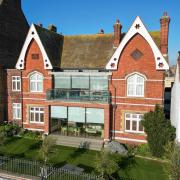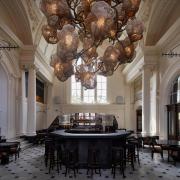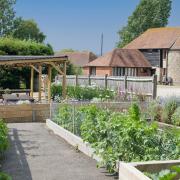There’s so much to love about this corner of Kent, with its unique landscapes, quiet beaches and great food and drink
1. Land and sea
There’s nowhere else quite like the Romney Marsh. Some 100 square miles of flat marshland, of which Dungeness is a part, it’s a diverse and beautiful landscape between the coast and the rolling hills.
Known for its largely unspoilt nature, it remains sparsely populated and has long attracted those trying to get away from it all. Villages and towns like Brenzett, Burmarsh, Old Romney, Hythe, Dymchurch, Lydd and St Mary in the Marsh are awash with history and ancient buildings and famed for their medieval churches.
Dark tales of its smuggling days add a certain mystery to the place and it’s bewitched many people of note over the years – including Noel Coward, who lived in Aldington for 30 years.
Its wide open spaces and big skies make it popular with artists and photographers, and stargazers love its lack of light pollution.
But it’s the area’s natural history that steals the show and there’s nowhere better to learn about it than at Kent Wildlife Trust’s Romney Marsh Visitor Centre in New Romney.
2. Shingle desert
It’s hard to describe Dungeness to someone who hasn’t experienced it. Both desolate and beautiful, it’s considered one of Kent’s most unique spots. A vast shingle beach that juts out into the sea, it’s fair to say it’s an unusual space, scattered with fisherman’s huts in various states of disrepair and overshadowed by the decommissioned nuclear power plant.
But this place is also an internationally important habitat for all sorts of species, with more than 600 types of plant alone – as well as all sorts of birds and some of the rarest insects in the country.
Though it's not safe to swim here, visitors come to walk the length of the beach (a boardwalk near the new lighthouse not only protects wildlife on the shingle but means access is made easier for those with mobility issues too), to explore the pebble garden of director Derek Jarman’s former home here, and to take photos of boats, lighthouses, sunsets and everything in between.

There’s a great little Snack Shack (open Wednesday to Sunday) where you can order freshly cooked seafood, as well as a pair of pubs – the Pilot and the Britannia – but there’s not a lot else. If you’re planning a visit, you may want to pack a picnic and prepare for quite a walk across the shingle to reach the sea.
3. Railway fun
If you’re visiting the Marsh there’s a very handy way to see much of its coastline. The Romney, Hythe and Dymchurch Railway, a heritage rail line with stations from Hythe to Dungeness, operates what’s thought to be the world’s most complete collection of one-third full-sized locomotives.
They look like vintage trains, just smaller. Looping back on itself at Dungeness, you can hop on and off along the way, exploring places like Hythe, Dymchurch, St Mary’s Bay and Romney Sands. A fun day out for all the family, it also runs numerous events throughout the year – including fish and chip suppers and Christmas specials. You can even try your hand at driving on special experience days or charter a train for a special celebration.
4. Beautiful beaches
The Romney Marsh didn’t exist a couple of thousand years ago, showing just how dramatically our coastline is capable of changing. By the time the Romans had invaded, a huge shingle barrier had built up between Hastings and Hythe, creating a lagoon behind it which they used as a natural harbour.
Over time it silted up creating the marshes we see today and eventually sea walls were constructed to stop it flooding, along with dykes that drain it. Luckily for us, it means that all the way from Hythe to Dungeness, nature created a series of beautiful beaches. Rarely as busy of some of the county’s more famous seaside towns, most are shingle but Dymchurch Beach is largely sandy and Hythe’s long beach is made of pebbles.
Great for swimmers and lovers of water sports, and popular with walkers at any time of year, some of our favourite beaches along this stretch of coast are Hythe, St Mary’s Bay, Littlestone and Greatstone.
5. Exciting events
Due to return this year after a COVID cancellation in 2021, Hythe Venetian Fete is the area’s grandest annual celebration, usually held every two years. Taking advantage of the Royal Military Canal running through the heart of Hythe, it sees the town turn out for a tableaux of decorated floats in various themes.
Alongside the floating extravaganza is live music, family entertainment and a huge fireworks display at dusk. This year it’s due on 17 August. And another big event on the Romney Marsh calendar is JAM on the Marsh – the local arts festival. Taking place between 7 and 17 July this year, it features world-class music, art, theatre, photography, poetry and workshops.
6. Glorious food

With rich agricultural land and a position along the coast, it’s no surprise that it’s known for its excellent local produce. Farmers have long grazed sheep on the marsh and their meat is considered such a delicacy that Romney Marsh lamb is exported in huge quantities to France each year.
With its flavour intensified by the salty grasses and samphire they consume, it comes into season in June and July and is served in many of the local pubs and restaurants. And seafood lovers will be in their element here too, with fishing fleets bringing in the catch each day and selling direct to many local eateries.
Spread out over such a large area, there are loads of great historic pubs, restaurants and cafés to try. Don’t miss Michelin-starred Hide & Fox, just outside Hythe, Twenty Four in Hythe and The Plough in New Romney.



























